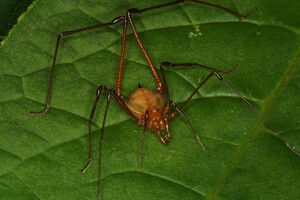| Asarcus | |
|---|---|
 Asarcus ingenuus (Mello-Leitão, 1940), São Paulo State, Brazil. Copyright © Ricardo Pinto-da-Rocha. | |
|
Suborder |
|
|
Superfamily |
|
|
Family |
|
|
Subfamily |
|
|
Genus |
|
Asarcus ingenuus (Mello-Leitão, 1940) is a species of the genus Asarcus C. L. Koch, 1839. Originally described in Bogdana Mello-Leitão, 1940, which was later synonymized with Asarcus [1].
Description[]
According to Yamaguti & Pinto-da-Rocha 2009:
Male: Measurements (N = 6). Dorsal scutum: length, 6.4–7.3 (6.8); width, 6.5–8.0 (7.5); anterior margin width, 2.6–3.1 (2.9); posterior margin width, 4.8–5.9 (5.1). Leg lengths: I, 13.2–16.6 (14.0); II, 32.8–43.1 (34.6); III, 24.4–31.5 (25.2); IV, 62.1–80.3 (?, tarsus broken). Femora lengths: I, 3.3–4.0 (3.6); II, 9.8–12.8 (10.5); III, 8.0–10.0 (8.0); IV, 15.3–23.4 (17.0).
Dorsum (Figs 14, 34, 115). Ocularium with large median tubercle. Anterior margin of prosoma with low granules. Area I of mesotergum with a pair of median tubercles; areas II and III with equal-sized granules. Free tergites II and III with median spine very small and wide at base.
Legs (Figs 14, 52, 71, 115). Coxa IV wider at apex. Metatarsus IV with two distal ventral rows of small curved spines.
Penis (Figs 92, 93). Dorsal process absent. Ventral process smooth, apex trilobed and ramified, with long branches. Stylus sinuous and with enlarged apex.
Coloration (live) (Fig. 115). Dorsum, leg coxae, and Trochanters red/brown. Posterior margin of dorsal scutum and posterior margin of free tergites yellow. Pedipalpus and chelicera yellow, reticulated with green. All leg femora through tarsi dark brown, almost black near the articulations; femur IV red/ brown, lighter than the dorsum, with all granules dark, almost black. Apophyses of coxa and trochanter IV, and spines of free tergites, black. Anal plate with same colour as dorsum, with median white spots on posterior margin. Venter lighter than the dorsum. In alcohol, the whole dorsum can be a homogeneous light yellow.
Dry marks (Fig.115). One pair of small white stains on lateral margins of prosoma, at ocularium sides. White median spots on anterior margins of areas II and III of dorsal scutum.
Female (Figs18, 35, 56, 75, 119): Measurements (N = 5). Dorsal scutum: length, 6.0–7.0; width, 6.6– 7.9; anterior margin width, 2.4–2.7; posterior margin width, 5.2–6.2. Leg lengths: I, 10.3–12.1; II, 24.9– 29.7; III, 18.4–22.1; IV, 29.2–35.2. Femora lengths: I, 2.4–3.2; II, 7.3–8.3; III, 6.2–6.8; IV, 7.2–9.0. Metatar- sus IV granulated, without the ventral rows of spines.
Comparison: Differs from other Bourguyiinae species in having metatarsus IV with two distal ventral rows of small curved spines, and posterior margin of dorsal scutum and free tergites yellow (Fig. 115). Differs from other Asarcus species in coloration (light reddish brown) of the dorsal scutum (Fig. 115).
Taxonomic History[]
Bogdana ingenua Mello-Leitão, 1940: 27 (desc.), fig.29; Kury, 2003: 107 (cat.) [Brazil, São Paulo, Campos do Jordão; holotype (MNRJ 127), examined].
Asarcus ingenuus: Soares & Soares, 1945b: 252, 254 (syst.); Soares, 1945f: 367; 1946: 510; Soares & Soares, 1949: 230 (cat., syst.); Soares, 1972: 55.
Asarcus nigriconspersus Soares & Soares, 1945b: 254, 259 (desc.), figs 5–6; 1949: 231 (cat.); Kury, 2003: 107 (cat.) [Brazil, São Paulo, São Francisco Xavier, December 1944, J. Damico leg.; holotype and one paratype (MZSP 827), two paratypes and two paratypes (MZSP 828), examined]. New synonymy.
References[]
- ↑ Yamaguti, H. Y. & Pinto-da-Rocha, R. 2009. Taxonomic review of Bourguyiinae, cladistic analysis, and a new hypothesis of biogeographic relationships of the Brazilian Atlantic Rainforest (Arachnida: Opiliones, Gonyleptidae). Zoological Journal of the Linnean Society, 156: 319-362.